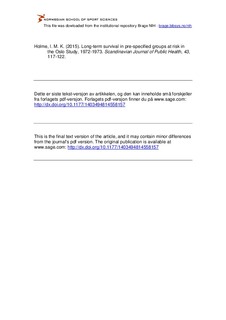| dc.description.abstract | Aims: Using the Oslo Study of 1972–1973, we wished to compare the long-term mortality pattern up to 40 years, in both the healthy cardiovascular groups at supposedly high and low risk, and in some groups having cardiovascular disease at screening. Methods: At the screening, 16,203 (63% of those invited) men aged 40–49 years participated. Study groups were identified by means of questionnaires regarding diseases, blood pressure and measurements of total cholesterol, triglycerides and glucose. We identified six groups: very high cholesterol, very high blood pressure, very high glucose, non-smoking with non-elevated such risk factors, from a randomized diet and antismoking trial, and a randomized drug treatment in mild-to-moderate hypertension. Statistical analyses were by Cox regression analysis, with Kaplan-Meier graphs. Results: The supposedly low-risk group had a total mortality of one-third of other groups, such as: men with hypertension, diabetes or hypercholesterolemia, or those whom participated in the two trials. Between these latter groups, we found 2–5 years of difference in their median survival time, but their absolute risk stayed at rather high levels through all the years, with the median remaining a lifetime that was 3–8 years shorter than the men whom were free of known cardiovascular disease, diabetes or hypertension. Conclusions: The long-term preventive effects on total mortality seem large, if the levels of the classical risk factors of blood pressure, total cholesterol and glucose can be adequately controlled, concurrently with a non-smoking behavior. The study indicated that non-smoking and a low total cholesterol value were the most important contributors to extended survival. | nb_NO |
